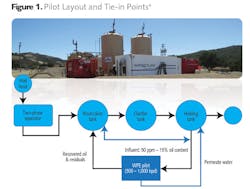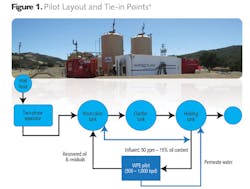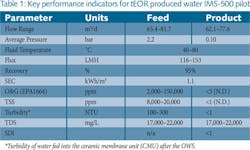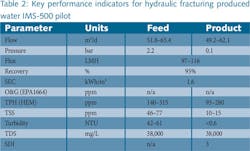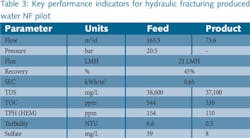By Arian Edalat and Eric Hoek
Extracting hydrocarbon resources co-produces a significant amount of water, which is industrially termed as produced water. How much produced water is generated at a given site is highly dependent on reservoir characteristics (age, geology) and production technique, and thus varies from one location to another. Water to oil ratios in oil and gas production reported across the United States vary from 2 to 43. The current national average is close to 5, and expected to increase to 12-15 by year 2020.1 Produced water is usually brackish or hyper-saline with considerable amounts of dispersed and dissolved hydrocarbons and solids.
Conventional produced water treatment for disposal and/or reuse involves a cascade of gravity-based mechanical separators designed to remove the dispersed hydrocarbons and suspended solids in stages. This cascade is often referred to as primary (gravity-induced flotation/sedimentation of free oil and suspended solids), secondary (air/gas-induced flotation of macro-emulsion) and tertiary (nutshell filtration of micro-emulsion). Advanced water treatment or desalination may follow. The dissolved hydrocarbons and remaining dissolved solids are then removed by thermal or membrane desalination.2,3 These technologies are highly reliant on the reliability and robustness of the pre-treatment provided. The problem with many of the conventional pre-treatment technologies is that rapid fluctuations in their influent (feed) water qualities cause variations in effluent water quality while significantly diminishing the efficiency of operation of these units.
Solution
The integrated membrane system (IMS) from Water Planet Inc. (WPI) operated here addresses the above issue by innovatively integrating accelerated gravity separation with ultrafiltration to create an absolute barrier towards dispersed hydrocarbons and suspended solids irrespective of the quality of the water upstream. Typically, the IMS removes free oil and suspended solids from up to 2 percent and 0.5 percent, respectively, to below 10 mg/L. It also consistently reduces turbidity to below 1 NTU while producing treated water with a silt density index (SDI) of 3 and below.
The platform consists of two main modules: an upfront mechanical oil-water-solid (OWS) separation module that reduces the bulk of the free oil and suspended solids followed by a ceramic membrane separation (CMS) module that polishes the remaining free and emulsified oil and suspended solids. Through robust materials of construction and ceramic ultrafiltration membranes, the IMS platform can operate continuously at influent temperatures up to 85oC. Here we report the performance of the platform during two recent field tests: one in a thermal enhanced oil recovery (tEOR) application in California and the other in a hydraulic fracturing application in Eagle Ford in South Texas. A pilot model of WPI’s IMS system, an IMS-500, with design throughput of 500 barrels per day was used for both of these cases.
Case 1: California
The site chosen for pilot was the Careaga lease in San Luis Obispo County, Calif., operated by Santa Maria Energy (SME). This location was specifically selected as it provided multiple tie-in points to verify the performance of the process when treating influents of varying oil and solid contents (few hundreds ppm to 15 percent). The challenging nature of the oil and solids in the produced water provided a platform to evaluate the robustness and reliability of the platform.
The site employs a cyclic steam stimulation (CSS) enhanced oil recovery technique and produces 100 to 200 barrels of heavy oil (15-18°API) per day. It also co-produces 5,000 to 7,000 barrels of produced water per day. Figure 1 shows the pilot site and various tie-in points.
Results
The system was operated in various phases over the course of two weeks. Figure 2 summarizes the characteristic results obtained throughout the pilot, and Table 1 presents characteristic key performance indicators for the IMS-500 pilot unit.
The membrane operation was initially challenged by fouling propensity of the feed water due to variability in feed oil and solids concentration as well as temperature swings. The fluctuating temperature and associated rheological changes to the feed fluid have a significant impact on the fouling propensity of produced water. For these tests, feed temperatures below 45°C were particularly challenging because the oil became denser than water.
The first 23 hours of the operation were spent on identifying the sustainable operating conditions, including filtrate flux and cross-flow velocity as well as the frequency of backwashing and cleaning actions. The optimum fouling management scenario was a combination of backwashing every 10 minutes for 8 seconds as well as an alkaline/acidic CIP every 50 operating hours. Less than 5 percent liquid waste was produced by the system. The average specific energy consumption for the mechanical and membrane components of the platform were evaluated at: 0.22 kWh/m3 and 0.84 kWh/m3 of throughput, respectively. The water had a TDS of 17,000-22,000 mg/L.
Case 2: Texas
A water management facility belonging to EXCO Resources, a natural gas and oil company engaged in the exploration, acquisition, development and production of onshore natural gas and oil properties in Eagle Ford Shale, near Batesville, Texas, was selected for this pilot. Flowback and produced water from hydraulic fracturing well pads were brought to this site for degassing and gravity separation of water, oil and solids. Flowback and produced water are transported by tankers for disposal via deep well injection, while separated oil goes to the point of sale by tanker. For feed into this pilot, WPI took a side stream from the gravity settling tanks and returned the treated water and the waste generated back into the tank farm.
Results
The unit was operated for 16.5 hours over the course of two hours. The feed water quality varied greatly, which is characteristic of centralized, produced water treatment facilities that receive wastewaters from numerous different production wells. The typical specific energy consumption for the IMS-500 system was 1.6 kWh/m3 (see Table 2). Consistent filtrate quality was observed throughout the operation, producing very high-quality feed to the downstream nanofiltration (NF) unit (SDI <3). The unit was a skid-mounted single membrane stage unit rated for up to seawater RO pressure ranges. The unit was rated for up to 500 barrels per day (79 m3/d) permeate production. NF membranes used were 8” Dow Filmtec NF90s. Results obtained were typical of a NF platform fed with highly saline waters (see Table 3). The most notable performance metrics were reduction in sulfate and dissolved organics removal of 80 percent and 40 percent, respectively.
Conclusion
Two field case studies were presented in which WPI’s integrated membrane system was applied to treat wastewater generated as a result of crude oil production. These were a thermal enhanced oil recovery application in California and a hydraulic fracturing application in Eagle Ford, Texas. On both occasions significant oil and grease and suspended solids removal were observed. While the feed water in both applications was highly varying in quality, the treated water quality was consistently good with turbidity <1 NTU. In the Eagle Ford case - and despite the highly saline quality of water - some dissolved solids and organics removal were also observed when a nanofiltration platform was used.
These case studies show that WPI’s system can be effectively used as a treatment option in such applications for discharge/disposal purposes, or as a robust and reliable pre-treatment to further downstream treatments such as membrane desalination to enable reuse.
About the Authors: Dr. Arian Edalat is vice president of engineering at Water Planet Inc. He has over 16 years of global experience in research, design, engineering, manufacturing, commissioning, and operation and maintenance of membrane-based water treatment technologies as well as oil water separation. He can be reached at [email protected].
Dr. Eric Hoek is CEO of Water Planet Inc. For over two decades, he has dedicated his life’s work to education, research, engineering, innovation, entrepreneurial and philanthropic activities related to his passion - water. He can be reached at [email protected].
References
1. Clark, C.E., and J.A. Veil. “Produced Water Volumes and Management Practices in the United States,” Report prepared by the Environmental Science Division, National Energy Technology Laboratory, 2009, ANL/EVS/R-09.
2. Ahmadun Fakhru’l-Razia, Alireza Pendashteha, “Review of technologies for oil and gas produced water treatment,” Journal of Hazardous Materials, Volume 170, Issues 2-3, 30 October 2009, pp. 530-551.
3. Igunnu, E.T., Chen, G.Z. “Produced water treatment technologies,” International Journal of Low-Carbon Technologies, Volume 9, Issue 3, September 2014, pp. 157-177.
4. Edalat, A., et al., “Pilot Test Results of Integrated Mechanical and Membrane System in Steam-Flood Produced Water Treatment,” IDA World Congress Proceedings, San Diego 2015.
5. ibid.
